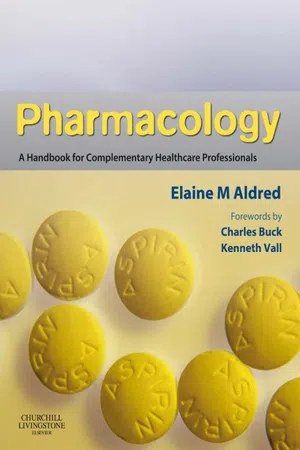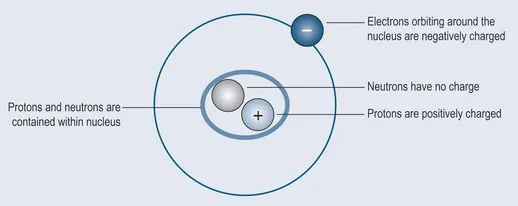
This is a test
- 376 pages
- English
- ePUB (mobile friendly)
- Available on iOS & Android
eBook - ePub
Book details
Book preview
Table of contents
Citations
About This Book
Pharmacology: A Handbook for Complementary Healthcare Professionals provides an accessible text and source book of pharmacology for both students and practitioners of complementary medicine. It covers the basic chemistry which builds into an understanding of basic organic chemistry, key pharmacological principles, herbal and nutritional chemical constituents and the use of conventional medication. Various different aspects are treated in a way, which creates linkages for clarity and clinical relevance.Written in an accessible style and highly illustrated throughout.
- Relevant to all students and practitioners of complementary medicine
- Easy to read
- Includes over 200 illustrations
- Written by a leading practitioner and lecturer in pharmacology
Frequently asked questions
At the moment all of our mobile-responsive ePub books are available to download via the app. Most of our PDFs are also available to download and we're working on making the final remaining ones downloadable now. Learn more here.
Both plans give you full access to the library and all of Perlego’s features. The only differences are the price and subscription period: With the annual plan you’ll save around 30% compared to 12 months on the monthly plan.
We are an online textbook subscription service, where you can get access to an entire online library for less than the price of a single book per month. With over 1 million books across 1000+ topics, we’ve got you covered! Learn more here.
Look out for the read-aloud symbol on your next book to see if you can listen to it. The read-aloud tool reads text aloud for you, highlighting the text as it is being read. You can pause it, speed it up and slow it down. Learn more here.
Yes, you can access Pharmacology by Elaine Mary Aldred in PDF and/or ePUB format, as well as other popular books in Medicine & Alternative & Complementary Medicine. We have over one million books available in our catalogue for you to explore.
Information
Topic
MedicineChapter 1 Introduction
This book has probably been in the making for at least 20 years. At Chiropractic College, I was forced to wade through enormous tomes on orthodox pharmacology in order to weed out those drugs relevant to my professional needs from the more obscure ones whose use was limited to the highly supervised environment of a hospital.
As a herbalist, my frustration only grew further as I found that the chemistry associated with the therapeutic use of herbs was presented in an equally technical manner, and seemly divorced from my clinical needs. Although these kinds of book are excellent as reference tools, for overloaded students or busy practitioners there is simply too much material to be sifted through in the time they might have available. Another problem can arise from the books’ authors being experts on the subject but usually not clinicians. This tends to make the material difficult to relate to everyday clinical practice.
Things finally came to a head for me when I was asked to teach pharmacology to herbal students, which made me actively address a subject that is considered by most students to be nothing more than a ‘hoop-jumping’ exercise in the process of becoming qualified. This made me seek a way of making pharmacology meaningful. To this end, I decided to teach pharmacology from the ground up, giving basic principles on which the students could build and relate to their clinical experiences.
Overcoming a natural resistance to the subject, however, is difficult on the grounds that pharmacology is perceived by students and practitioners as subject only accessible to those with a scientific frame of mind. On a workable clinical level this is simply not true.
I was certainly not the most adept scientist at school and found my university course a trial. I realized later that this was because my subject was being presented from a purely academic viewpoint, with little reference to its application in the real world. I need – like many other complementary practitioners when presented with pure science – my work to be linked to the information presented if it is to be meaningful.
So, when writing this book I decided to cut the principles of pharmacology back to the bare minimum to leave a platform from which to present the subject as applicable to the complementary healthcare profession. Although this book can be used as a quick-reference book for a specific subject, if the reader takes time to methodically work through it, then pharmacology in field of herbal medicine, nutrition and orthodox medicine not only becomes clear but also a source of enlightenment. This enlightenment should break down the final resistance to a subject that is not only fascinating but empowering to the practitioner who grasps it with both hands. Taking it on board, it is possible to see that art and science can live side by side, providing you have an open mind.
Having said this pharmacology is not an area of instant comprehension. Like playing a musical instrument, it takes time to build up proficiency. The way the book has been constructed, however, with numerous cross-referencing, should make the process easier.
This book has not been written as a definitive guide to every possible aspect of pharmacology, in fact it might, by those well-versed in the subject, be criticized as too simplistic. I have for example mainly used bibliographies, restricting references to instances where the material is not commonly found in the textbooks available on the subject. It is my experience that in a book of this nature too many references are off-putting.
Any omissions are generally in areas where the items are not normally encountered in clinical practice, e.g. in Chapter 22 ‘Terpenes’, sesterpenes – which are not normally found in plant material – have been left out, as have the more obscure orthodox drugs. I have relied on 20 years of clinical experience to cover the subjects you are mostly likely to need on a daily basis; the final chapter outlines some basic principles on how to investigate a query further.
Pharmacology can be learned by rote, so it is possible to know that flavonoids are antioxidants or that chemotherapy kills cancer cells. However, understanding the underlying principles of pharmacology enables a practitioner to use it intelligently: to see beneath a presenting condition to recognize that it might be a side effect of a drug, or to anticipate a possible interaction of a herb with a drug.
A reasonable grasp of pharmacology is rapidly becoming a necessary skill in the field of complementary medicine as the choice and use of orthodox medications becomes more complex and might possibly impact on the treatment being given.
A Few Notes on the Text
On the basis of ‘a picture speaks louder than words’, chemical structures will be shown where appropriate to give the reader a better understanding as to why a particular chemical might exert a particular effect or merely for comparison with a chemical of a similar property. However, some orthodox medication for instance that used for epilepsy is so varied that it is not possible to relate structure to function so easily.
The ‘orthodox medication’ sections do not cover the more specialized medications or medication that is used only with close medical supervision, e.g. hospital use, unless it is in some way relevant to clinical practice.
Throughout the book, unless a specific topic is being discussed, the generic name of chemical will be used. This might refer to a component of a herb, nutritional supplement, food or drug.
The priority in which medication is given will not be discussed as the guidelines dictating the order in which, for example, hypertensive drugs should be administered alters depending on new research that emerges. A chapter outlining sources for such information is included at the end of the book.
As none of the readers of the book will be prescribing medication, it is enough to be aware of their respective country’s guidelines, for example the National Centre for Health and Clinical Excellence (NICE) in the UK produces guidelines for doctors to follow.
There is an element of ‘chicken and egg’ to presenting pharmacology, in that it might be necessary to introduce complex molecules before the reader actually needs to understand them more detail. However, for the sake of completeness and cross-referencing (always a good method of understanding a subject) they have been included briefly.
Conclusion
If you take the time to work through the book systematically you will be able to start to read drug and herbal monographs in more depth and with more application, and to interpret research papers to a reasonable degree and relate them to your clinical experience. The final chapter in the book gives information on reliable websites and also a very basic introduction to aspects of evidence-based medicine and pure laboratory research.
Understanding the principles of pharmacology will enable you to make more informed choices in the treatment of your patients and will add to your ability to successfully manage a case.
Section 1
Basic pharmacological principles
Chapter 2 The atom
The smallest unit of pharmacology
Chapter contents
What is an atom? 7
The structure of an atom 9
The electron is the key to pharmacology 9
To achieve a confident working knowledge of pharmacology you need a sound understanding of the structure, and therefore the function, of the basic unit of chemistry: the atom.
What is an Atom?
• An atom is the smallest complete unit that cannot be broken up by chemical means. It has chemical properties in its own right.
• Atoms of exactly the same composition behave in exactly the same way in chemical reactions.
• These identical atoms are called elements (later in the text, this term will be used interchangeably with atom).
• Different atoms or elements can combine with each other to form chemical compounds, which can be relatively small, like a water molecule, or extremely large and complex, like the DNA helix.
Atoms consist of (Figure 2.1):
• a nucleus
• electrons orbiting around the nucleus.

Figure 2.1 Composition of an atom. Overall charge is neutral as the negative charge of the electron orbiting around the nucleus is neutralized by the positive charge of the proton in the nucleus.
The Nucleus
The nucleus is made up of protons and neutrons:
• Protons have a positive charge.
• Neutrons have no charge.
For the level of pharmacology covered in this book, the presence of neutrons is acknowledged here for completeness but they will not be discussed any further.
T...
Table of contents
- Cover
- Title Page
- Copyright
- Foreword (Charles Buck)
- Foreword (Kenneth Vall)
- Acknowledgements
- Table of Contents
- Chapter 1: Introduction
- Section 1: Basic pharmacological principles
- Section 2: Important primary metabolic components
- Section 3: Pharmacokinetics and pharmacodynamics
- Section 4: Plant pharmacology
- Section 5: Orthodox medication
- Section 6: Toxicology
- Section 7: The final analysis
- Index